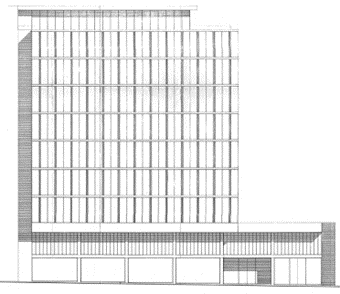Jose Antonio Coderch and His Unexplored Work
The Diagonal Beethoven Building in Barcelona
DOI:
https://doi.org/10.18861/ania.2023.13.1.3415Keywords:
Commercial Architecture, Coderch, Spanish Architecture, 20th century, user-focused solutions, architectural designAbstract
This article, presents, analyses and discusses the Diagonal Beethoven Building, an unexplored work by one of Spain’s leading 20th-century architects, Jose Antonio Coderch. The building displays elements that are characteristic of the architect, in large part rooted in the tradition that forged his highly distinguished style. From the search for light and user-focused solutions for curves, windows, courtyards and corners to the smallest of interior details, which highlight his skill in the resolution of construction joints and his handling of materials, Coderch applied his architectural style in single-family homes, multi-family homes and office blocks. This article helps to expand our understanding of his work and its evolution, providing a common thread, because of their shared period, use and geographical proximity, that includes some of his emblematic projects broadening our knowledge of his legacy and the era in which he lived.
Downloads
References
Andreu Muñoz, R.; Canyelles Torrents, N. (2017). Projecte Bàsic i d’Execució de Reforma de Façana d’un Edifici d’Oficines.
Arís, C. M. (2006). Dos aportaciones sustanciales sobre las obras de Coderch y de Mies van der Rohe. Quaderns d'arquitectura i urbanisme, (249), 110-113.
Armesto, A. (2009). La cabaña de Semper, según José Antonio Coderch. Quaderns d'arquitectura i urbanisme, (259), 98-107.
Barahona, M. (2016). “José Antonio Coderch: Arquitectura al servicio del hombre”. Houzz; link: shorturl.at/irxA1
Capitel, A. (1986). The Modern Adventure of Spanish Architecture, 1949-1970. Solá-Morales Rubio, Ignacio; Capitel, Antón et al, Contemporary Spanish Architecture. An Eclectic Panorama, Nueva York, Rizzoli, 11-19.
de Rentería Cano, M. (2013). Detalles en la arquitectura de JA Coderch (Doctoral dissertation, Universitat Ramon Llull).
de Rentería Cano, I. (2014). El fondo de la ventana en la arquitectura de JA Coderch. In I Congreso Pioneros de la Arquitectura Moderna Española: Vigencia de su pensamiento y obra: Actas digitales de las Comunicaciones aceptadas al Congreso. (pp. 752-763). Fundación Alejandro de la Sota.
El Periodico (2012). “Las pioneras torres negras y onduladas”. Link:
https://www.elperiodico.com/es/les-corts/20120509/las-pioneras-torres-negras-y-onduladas-1760843
Freixas, À. S. (1967). La obra reciente de José Antonio Coderch. Cuadernos de arquitectura, 21-26
Lejeune, J. F. (2009). The modern and the Mediterranean in Spain: Sert, Coderch, Bohigas, de la Sota, Del Amo. In Modern Architecture and the Mediterranean: Vernacular Dialogues and Contested Identities (pp. 65-94). Routledge Taylor & Francis Group.
Llinàs, J. (2002). Saques de esquina. Moisés Puente Rodríguez.
Llobet i Ribeiro, X. (2020). “Edificios Trade”. Docomomo. Link: shorturl.at/vzDI5
Mao, Y. (2014). " Feng Shui" y arquitectura occidental: el caso de Josep Antoni Coderch (Master's thesis, Universitat Politècnica de Catalunya).
Montaner, J. M. (1994). Ensayo sobre arquitectura moderna y lugar. Link: shorturl.at/wAQUX
Montis Sastre, T. (2013). La arquitectura de la esquina, tres arquitectos: Jujol, Coderch y Llinàs.
Pérez Gutierrez, M. C. P. (2009). Evolución del tipo estructural" Torre" en España: Madrid, Barcelona, Benidorm (Doctoral dissertation, Universidad Politécnica de Madrid).
Pizza de Nanno, A. (1983). José Antonio Coderch de Setmenat o las coincidencias imposibles: reflexión sobre algunos ejemplos de arquitectura residencial. Annals. 1983, núm. 3.
Soria, E. Conversaciones con J.A, Coderch de Sentmenat. Colección Arquitectura nº32, Colegio Oficial de Arquitectos Técnicos de Murcia, 1997, 84.
Tomás Bosch, G. (2013). 43, 49, 66, 71 Amigó – Via Augusta – Santaló. Francesc Mitjans, Jose Antonio Coderch. Universitat Politècnica de Catalunya.

Downloads
Published
How to Cite
Issue
Section
License
Copyright (c) 2022 Jaume Hernando

This work is licensed under a Creative Commons Attribution 4.0 International License.
The journal and its contents are licensed under the Creative Commons - Attribution 4.0 International License (CC BY 4.0). It is possible to copy, communicate and publicly distribute its content as long as the individual authors and the name of this publication are cited, as well as the publishing institution (Universidad ORT Uruguay).

